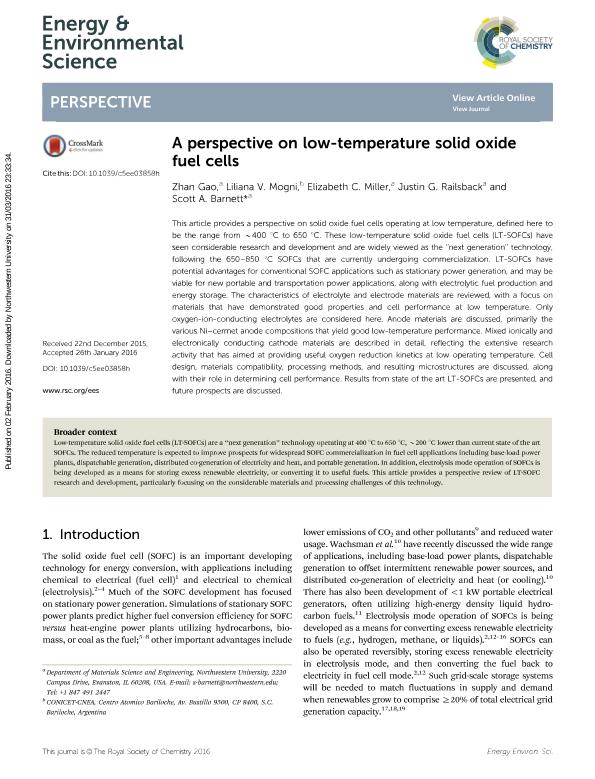Mostrar el registro sencillo del ítem
dc.contributor.author
Gao, Zhan
dc.contributor.author
Mogni, Liliana Verónica

dc.contributor.author
Miller, Elizabeth C.
dc.contributor.author
Railsback, Justin G.
dc.contributor.author
Barnett, Scott A.
dc.date.available
2018-09-18T15:12:51Z
dc.date.issued
2016-05
dc.identifier.citation
Gao, Zhan; Mogni, Liliana Verónica; Miller, Elizabeth C.; Railsback, Justin G.; Barnett, Scott A.; A perspective on low-temperature solid oxide fuel cells; Royal Society of Chemistry; Energy & Environmental Science; 9; 5; 5-2016; 1602-1644
dc.identifier.issn
1754-5692
dc.identifier.uri
http://hdl.handle.net/11336/60078
dc.description.abstract
This article provides a perspective on solid oxide fuel cells operating at low temperature, defined here to be the range from ∼400 °C to 650 °C. These low-temperature solid oxide fuel cells (LT-SOFCs) have seen considerable research and development and are widely viewed as the "next generation" technology, following the 650-850 °C SOFCs that are currently undergoing commercialization. LT-SOFCs have potential advantages for conventional SOFC applications such as stationary power generation, and may be viable for new portable and transportation power applications, along with electrolytic fuel production and energy storage. The characteristics of electrolyte and electrode materials are reviewed, with a focus on materials that have demonstrated good properties and cell performance at low temperature. Only oxygen-ion-conducting electrolytes are considered here. Anode materials are discussed, primarily the various Ni-cermet anode compositions that yield good low-temperature performance. Mixed ionically and electronically conducting cathode materials are described in detail, reflecting the extensive research activity that has aimed at providing useful oxygen reduction kinetics at low operating temperature. Cell design, materials compatibility, processing methods, and resulting microstructures are discussed, along with their role in determining cell performance. Results from state of the art LT-SOFCs are presented, and future prospects are discussed.
dc.format
application/pdf
dc.language.iso
eng
dc.publisher
Royal Society of Chemistry

dc.rights
info:eu-repo/semantics/openAccess
dc.rights.uri
https://creativecommons.org/licenses/by-nc-sa/2.5/ar/
dc.subject
Celdas de Combustible de Oxido Solido
dc.subject
Perspective
dc.subject
Anodos
dc.subject
Electrolitos
dc.subject
Catodos
dc.subject.classification
Recubrimientos y Películas

dc.subject.classification
Ingeniería de los Materiales

dc.subject.classification
INGENIERÍAS Y TECNOLOGÍAS

dc.title
A perspective on low-temperature solid oxide fuel cells
dc.type
info:eu-repo/semantics/article
dc.type
info:ar-repo/semantics/artículo
dc.type
info:eu-repo/semantics/publishedVersion
dc.date.updated
2018-09-10T15:54:09Z
dc.journal.volume
9
dc.journal.number
5
dc.journal.pagination
1602-1644
dc.journal.pais
Reino Unido

dc.journal.ciudad
Cambridge
dc.description.fil
Fil: Gao, Zhan. Northwestern University; Estados Unidos
dc.description.fil
Fil: Mogni, Liliana Verónica. Consejo Nacional de Investigaciones Científicas y Técnicas; Argentina. Comisión Nacional de Energía Atómica. Centro Atómico Bariloche; Argentina
dc.description.fil
Fil: Miller, Elizabeth C.. Northwestern University; Estados Unidos
dc.description.fil
Fil: Railsback, Justin G.. Northwestern University; Estados Unidos
dc.description.fil
Fil: Barnett, Scott A.. Northwestern University; Estados Unidos
dc.journal.title
Energy & Environmental Science

dc.relation.alternativeid
info:eu-repo/semantics/altIdentifier/doi/https://dx.doi.org/10.1039/c5ee03858h
dc.relation.alternativeid
info:eu-repo/semantics/altIdentifier/url/http://pubs.rsc.org/en/Content/ArticleLanding/2016/EE/C5EE03858H
Archivos asociados
